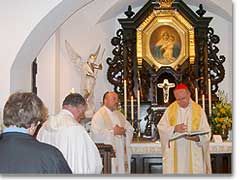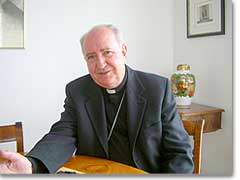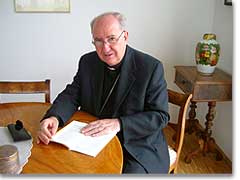 |
|
Cardenal Francisco Javier Errázuriz, Misa en el Santuario Original Cardinal Francisco Javier Errázuriz, Mass in the Original Shrine Kardinal Francisco Javier Errázuriz, Messe im Urheiligtum |
|
 |
|
Entrevista en Monte Sión Interview at Mount Sion Interview auf Berg Sion |
|
 |
|
Entrevista en Monte Sión Interview at Mount Sion Interview auf Berg Sion Fotos: POS Fischer © 2005 |
SCHOENSTATT, mkf. Before returning to Chile and after having participated in the conclave in Rome, Cardinal Francisco Javier Errázuriz, archbishop of Santiago in Chile and President of the Latin Amerian Episcopal Counsil (CELAM), visited Schoenstatt on April 29th and 30th. There he celebrated mass in the Original Sanctuary and met with his Community of Schoenstatt Fathers. The Schoenstatt Press did not miss the opportunity for an exclusive interview. Here is the publication of the second part of the interview. (part one)
- Can you share with us any personal experiences with the new Pope?
Yes, I can gladly share a couple of small events…His home, the papal apartment, was not ready (they probably had to paint it and make room for his well-nourished library and other things of the sort). For this reason, an apartment near the papal rooms had been arranged for him. But he did not stay in it: he remained in the house where he lived during the conclave, ate with the other cardinals and greeted them as a simple man… Interesting! When he had to work, prepare some homilies, he would go to his old apartment, outside of the Vatican, and would stay there two or three hours. It is also amazing that the first thing he did when he went to that building was go, from door to door, to the other apartments and greet all the sisters that work in the houses of the cardinals. In other words: a tenant of that building has become Pope and cordially greets the others.
The day before yesterday, the members of the presidency of the Latin American Episcopal Conference had an audience with him. He did not wait for us to be seated at his desk; instead, he came out of the room, greeted each one of us personally and invited us in. After the audience we left the living room chatting. Suddenly we could hear: "the Pope is coming!" As he walked, as usual to Saint Martha’s House. He doesn’t travel in a big car, he goes on foot. He doesn’t like the car because it has a small throne in the interior. He will most likely have it removed! He is happy with simplicity and humility. During the Initial Mass of his pontificate he wanted to say his homily standing up, and when he was about to stand up, the master of ceremonies gestured for him to be seated. On this occasion he followed protocol, but will he do it in the future? There is no doubt that there is less tension being seated, but he wanted to stand up. His humility makes him very pleasing. He is a very affable man.
- How much does Pope Benedict XVI know about Schoenstatt? We know he has frequently visited different Sanctuaries. What other connection does he have with Schoenstatt? Since you’ve been in Rome for some years, what can you tell us about the Pope’s opinion regarding Schoenstatt?
These questions can be better answered by Sister María, who has been his secretary. (Explanation: Sister Birgit Wansing, Schoenstatt Sister of Mary, has been the personal secretary and right hand of Cardinal Ratzinger in the Vatican for the last 14 years).
His knowledge about Schoenstatt varies. The first time I talked with him, was about the "Consecration – contract" in the Schoenstatt Institutes. (Explanation: members of the Schoenstatt Secular Institutes only have a contract as a link with the community, which can be revoked at any time by the member).
He answered immediately: I don’t understand it, but this follows the direction of ultimate freedom that the Council has wanted to give to each Christian, and I would be pleasured to support it. I want to strive for the same thing. If this was important for Father Kentenich, and given that it is directed toward ultimate freedom, I very much want to support you with this decision.
On a later occasion, we have talked about the Holy Letter’s decisions of our Founding Father in 1965. He allowed me to have access to secret records of the Holy Letter. Therefore, I was able to read how the correspondence took place, also what was later written by Cardinal Ottaviani about our Father, and many other things. He is a man who searches the truth and brings access to it. He doesn’t defend anyone’s privileges. This makes us very happy!
I have talked to him on different occasions, always with sympathetic understanding on his part. I suppose he knows a lot about Schoenstatt, but is so humble that he doesn’t speak a great deal about it. It is difficult to know how much he knows about Schoenstatt, or about many other things. He is a man who has studied much and does not forget what he has learned.
- After the election of Pope Benedict XVI someone said: Now I really believe in the Holy Spirit’s action… How have you experienced in Rome, in the conclave, the Holy Spirit’s action?
All the cardinals that participated in the conclave went with an open heart to the Holy Spirit. The election process is unique. The meeting is in the great Chapel, we pray the litany of all the saints, and invoke the presence of the Holy Spirit. A deep silence fell in our hearts. Then, the Gospel is proclaimed, which is followed by a long homily. And then there is a nervous tension when each one starts casting his vote.
There can not be any previous agreements; neither can any one promise to favor or be against a candidate. This is very important and anyone who campaigns to get votes or pressurizes someone to vote for a specific person or not vote for a specific candidate would be excommunicated. It’s all about freedom, it should be a field of freedom, an open field so that each one’s conscience can talk and be open to the Holy Spirit’s action. When the votes are cast the voter is before a huge crucifix and behind him is the great fresco of the Final Judgment. Then, one should proclaim out loud: I take God, Jesus Christ, as witness, that I cast my vote for the person that should be Pope. This oath is heard 115 times. This is done to open the interior field of our conscience and let the Holy Spirit work so the person that God wants can be elected. It’s a very beautiful process.
- It is precisely this process that the public opinion has trouble understanding. Doesn’t it become clearer this way that elections, decisions, not always have to be determined by partisanship or to make coalitions and "elections campaign"?
Before the conclave, when all the cardinals met, they already had a vision of the Church in the world and of the world’s situation in the different continents and different countries. The cardinals were well-informed about the situation in India, Uganda, Latin America, Switzerland, everywhere. This way, we knew where the Church is in the world, and the conflicts and struggles that it faces. This is one side of the coin.
Before the conclave the cardinals have to have a concrete idea about the candidates that could be elected Pope. The journalists did not grossly err in this field. They talked with many people and at the end they had in their hands a list of the names that pretty much agreed with reality. One could say, well, I want to be clear about each one of the fifteen most mentioned names. This is not easy. For example, the cardinal’s opinion about the Movements, is interesting, which is something essential for the future of the Church; how is his health? In controversial situations, why did he decide this or that? How has he lead his diocese? How did he perform as the president of an Episcopal Conference? And there are many other questions to be made in order to clearly know the profile of a cardinal.
Then, the internal field must be opened, so that God may speak with complete clarity. It was obvious in the face of some cardinals that they had no idea for whom they would vote. One of them told me: after the speech in which the older cardinal spoke about the election, for the first time I had clarity about who I should vote for. The conclave is a very religious process, a very spiritual experience.
- Is the World Youth Day, John Paul II’s legacy, an opportunity to nurture the enthusiasm that the Church has now awakened? How can this be done?
I remember the World Youth Day in Paris. The French bishops were not expecting the participation of many youth. They estimated that a maximum of between 200,000 and 500,000 would arrive in Paris. And suddenly, there was a million youth present. They were astonished. What attractive power does this man, this Pope have? But the really interesting thing happened later. All the bishops and many French parish priests traveled to Rome for the World Youth Journey in the year of the 2000 jubilee, to "trap" youth for the parish work, because in France they did not have any contact with them. Where the Pope went, there were the French youth! They went to Rome as confessors, to be in contact with the youth. And later, the French bishops and many priests, traveled to Toronto, to once again "fish" the French youth for the Church in France. This is an interesting example. They were open, they said to themselves: this is a phenomenon; we have to go and fish where the Pope is in order to have contact with our youth!
- Many people say that because of this sudden appearance of pilgrims in Rome – the fact that John Paul II shines as much and as the new Pope conquered the hearts quickly – one could think that it is all related with the blessing of the Matri Ecclesiae Sanctuary last September. Are we, perhaps, experiencing this now because of all our prayers? Can you possibly see a link there that will become a task for us, as the Schoenstatt Movement?
No doubt there is a relationship. I hope that all of us in Schoenstatt on one side are conscious of the spiritual heredity of our Founding Father. Our Father has made many contributions for the future of the Church, and this is something very obvious for us. We have to have much contact with other trends in the Church, with other charismas; this way we’ll be able to clearly see what Schoenstatt’s contribution is. This contribution is very valuable and the Church needs it. On the other side, we should more aware of evangelization. We should not think: I lead a good life, I have the Home Shrine, my children pray every once in a while to the Virgin Mary… We should see to what degree people thirst for God. If we open the way to the Virgin Mary, then they will have a deep meeting with Christ.
How are the ties among men destroyed, how many problems do marriages at present! We need to state with a lot more courage what we have received as a spiritual inheritance and see what links we have with other Movements and members of other communities. This can greatly help us in churches, associations and neighborhoods, and then we can take the Pilgrim Mother to those who are searching for God.
This is a time in which faith will develop or be a victim of history. We can not stay neutral. We need to be active. That is what our Father did during his entire life. He has confronted many trends of time and has dedicated all his strength to the formation of the Schoenstatt communities. It is incredible how he opened his fatherly heart to so many people, how he has helped so many to transform their lives. It is clear to us: the aspiration to sanctity should be linked to the effort for the souls, for the renovation of the Church, for evangelization.
It is very beautiful how in many places the diocesan priests value what they get from Schoenstatt. Is it only for the work with the trends of time or something that is normally not done and that they recognize it as important? Or is it in the pastoral pedagogy, the importance of freedom, the link to the ideal… These are very valued Schoenstatt contributions, but we must offer them and proclaim them with much conviction!
Translation: Natalia Cava, Florida, USA, Pat McEvoy, Liverpool, England